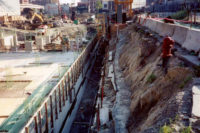Consider Value Engineering Your Waterproofing Design
A Look at the Costs, Benefits and Considerations

In the last decade the term “value engineering” has gained prominence in the construction industry.
The main objective of value engineering is to maximize the project’s function while minimizing the project cost. This process typically occurs during the pre-construction phase and provides an opportunity for the initial project participants (Owner, Designer, Project Manager/General Contractor) to review the design documents and project criteria. A functional analysis of the facility is conducted to determine key criteria for the building and offer alternative solutions for design, materials and application methods.
One benefit of value engineering is the cost reduction to the project that it can achieve. This is accomplished with less expensive alternatives to specified materials or systems. The key benefit—which is difficult to achieve—is to maximize the function of the building. This can only be achieved if the design solutions that are incorporated into final construction are more functional than the originally designed materials or systems. In recent years the focus has been on the increased use of sustainable materials and energy efficiency.
Value engineering is defined as a success if it meets the following options:
• Cost reduction: suggestions of less expensive alternatives to specified materials or systems
• Value added: higher quality products that will increase value for the client and overall satisfaction with the project
• Life-Cycle Analysis: options that work to create a balance between initial construction costs and the long-term operational budget of the development
• Maintainability: recommendations of systems and products that will reduce maintenance costs over the lifespan of the building
In the case of most building components—interior or exterior—changes to materials or application methods may in fact provide cost savings and have little or no impact on the life span of the building. The component where value engineering could prove to be detrimental is exterior waterproofing, particularly below-grade waterproofing. If a building owner wants to cut costs, the waterproofing system is the last place to do so. Because improper below grade waterproofing would not only serve as a risk, the cost of repairs—even minor repairs—would be costly.
The reason for this is that in below-grade waterproofing the cost of excavation far exceeds the initial cost of application. For instance, an opening may be located deep below the surface requiring removal of overburden, such as trees, concrete, landscaping, followed by excavation of soil to reach the point of moisture infiltration. Once the repair is made everything must be put back. Even if the actual repair is as simple as a 2’ x 2’ patch, the cost of excavation and replacement may exceed initial application costs. Can you imagine if another leak or multiple leaks occur at different time frames, the total costs would be excessive.
The acceptance of any value engineering proposal for waterproofing should be based on risk vs. cost basis. In consideration of the below grade waterproofing process, i.e. design and application, the best adage is too error on the side of caution. Therefore, the designer should always minimize risk despite any reasonable—or unreasonable—costs. With waterproofing you only have one chance to do it right!
Value engineering changes should match the due diligence required at the initial design stage. The project team should evaluate the materials/systems that are suggested and ensure that they are value added changes. For value engineering recommendations to be approved the changes to the material and/or application process should meet the requirements of proper waterproofing material selection.
The material selection process is divided into two equally important phases. The initial design phase involves consideration of membrane material suited for the specific building. Site specific issues and building requirements necessitate proper consideration. There are several site-specific considerations involved in the selection of the waterproofing material, some of the considerations are as follows:
• Occupancy
• Water Table
• Soil Characteristics
• Substrate Stability
• Construction Sequence
• Risk v. Cost
Proper membrane consideration should ensure that the membrane material meets all the following criteria:
• Resistant to Hydrostatic Pressure
• Chemical Resistant
• Low Water Absorption Rate
• Flexibility
• Performance in High Ground Water
• Ease and Safety of Application
The selection of the application process should ensure that the membrane is fully adhered to the substrate (concrete, wood, gypsum) and should be placed at all exterior substrate points down to the base of the structure.
Value engineering can be successful on waterproofing projects if the membrane provided meets all of the proper design considerations. If the membrane material chosen is not functional for site-specific requirements—and is only based on initial cost savings—the process may ultimately prove detrimental. With waterproofing you only have one chance to do it right!
Looking for a reprint of this article?
From high-res PDFs to custom plaques, order your copy today!







